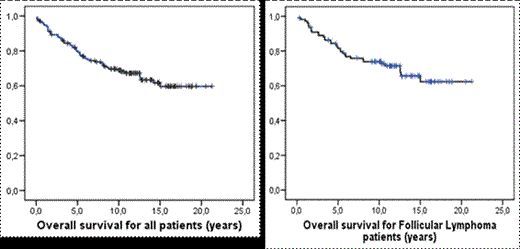Abstract
Introduction: Indolent B cell non-Hodgkin lymphomas are entities without curative treatment nowadays. However, survival has significantly improved since the incorporation of immunomodulatory agents and now immunochemotherapy has become the gold standard. Most treatment strategies use progression free survival (PFS) as a surrogate marker for overall survival (OS), although updated long term results are frequently lacking. Since 1990 our group introduced IFNα-2b to Bagley’s CVP induction regimen, for naïve indolent NHL (LNH-pro study). Herein we report our long term results.
Aim: To evaluate long term outcome and late toxicities of patients who received immunochemotherapy with IFN α-2b plus CVP.
Patients and Methods: From February 1990 to November 2001, patients from 7 Spanish institutions were included. Induction therapy consisted of Cyclophosphamide (400 mgs/m2 po) and Prednisone (100 mg/m2 po) daily for 5 days, Vincristine (1.4mg/m2 iv) on day 1, and subcutaneous IFN α-2b (3 MU/m2, three times a week, for a total of 36 doses). Patients received the number of cycles necessary to achieve maximum response. Updated clinical data were retrieved from participating centres up to March 2012.
Results. A hundred and seventy patients with low-grade NHL were analyzed. Included entities were: 65% grade 1-2 follicular lymphoma (FL), 21% lymphocytic lymphoma and 14% marginal zone lymphoma. Median age was 56 yo (range 22-78 yo), elevated LDH and β2-microglobuline were 13.6% and 26% respectively, 57.6% had bone marrow involvement and 7.6% bulky disease (>7cm). According to FLIPI, 33% were high risk, 40% intermediate and 27% low risk FL.
Median number of cycles was 6, and overall response rate achieved was 90%, with 68% complete remissions. Median follow up of surviving patients was 12.5 years (range 3-21 ys), with only 14.7% of patients lost to follow-up.
Median PFS for all patients was 12.5 years (95% CI 10.5 – 14.5 years) and not reached for FL patients (20-year PFS of 63%; 95%CI: 54-72%). Median OS has not been reached, with a 20-year OS of 59.7% (CI 95%, 50.5-69%) for all low-grade NHL patients and 62% (IC 95%, 50-74%) for FL patients. Long-term toxicity is detailed in table 1. Incidence of secondary malignancies is 13.5%. At time of analysis, 57 out of 170 patients have died (33.5%), mainly due to lymphoma (58% of patients) and other non-lymphoma events (42%).
| Secondary malignancies . | 23 cases (13.5%) . |
|---|---|
| - MDS / AML | 3 cases |
| - Solid tumors | 18 cases |
| - Dermatologic neoplasia | 2 cases |
| Causes of death | Number of patients (%) |
| Induction toxicity events | 4 (7%) |
| Lymphoma progression / relapse | 29 (51%) |
| Secondary malignancies | 9 (16%) |
| Other non-lymphoma events | 15 (26%) |
| - Miocardiopathy | 4 |
| - Chronic Pulmonary disease | 3 |
| - Hepatic failure | 2 |
| - Brain traumatic injury | 1 |
| - Unknown cause | 5 |
| Secondary malignancies . | 23 cases (13.5%) . |
|---|---|
| - MDS / AML | 3 cases |
| - Solid tumors | 18 cases |
| - Dermatologic neoplasia | 2 cases |
| Causes of death | Number of patients (%) |
| Induction toxicity events | 4 (7%) |
| Lymphoma progression / relapse | 29 (51%) |
| Secondary malignancies | 9 (16%) |
| Other non-lymphoma events | 15 (26%) |
| - Miocardiopathy | 4 |
| - Chronic Pulmonary disease | 3 |
| - Hepatic failure | 2 |
| - Brain traumatic injury | 1 |
| - Unknown cause | 5 |
Conclusions: Our results confirm that immunochemotherapy with IFN α-2b plus CVP regimen induces a median PFS of 12.5 years and a 20-year OS of 59.7% (median not reached). With a median follow-up of 12.5 years, 58 % died due to lymphoma, 16% from secondary malignancies and 26% for non-lymphoma events. These results highlight the importance of performing long term follow-up in order to assess the real survival benefit of any treatment.
No relevant conflicts of interest to declare.
Author notes
Asterisk with author names denotes non-ASH members.


This feature is available to Subscribers Only
Sign In or Create an Account Close Modal